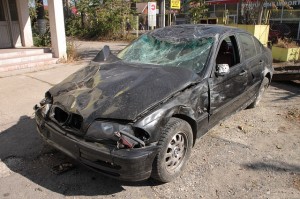 This year, many parts of the country have enjoyed such a mild winter that even in the Northeast, spring weather seems like it’s just around the corner—if it hasn’t arrived already.
This year, many parts of the country have enjoyed such a mild winter that even in the Northeast, spring weather seems like it’s just around the corner—if it hasn’t arrived already.
Take advantage of the moderate temperatures to get a head start on what should be an annual spring home maintenance routine.
EXTERIOR INSPECTION
“It’s good to do a walk-around of your property, especially after a storm,” says Curtis S. Niles, Sr., owner of Armored Home Inspections, Upper Darby, PA, and president of the National Association of Home Inspectors (NAHI). “Winter is tough on roofs and chimneys.” It can also take its toll on windows, walls, foundations, gutters and decks.
Roof. You don’t need to climb up there yourself; with binoculars and a keen eye, you can probably spot trouble. Do you see any shingle-shift, suggesting that some fasteners may have failed and need replacing? Any cracked or missing shingles? What about nail-pops? “We call them eyebrows,” Niles explains. “It’s when nails push the tabs of the shingles up, allowing water to get in where those nails are coming through.” All will need to be addressed to keep your roof at peak performance.
Chimneys. If you have a masonry chimney, check the joints between bricks or stones. Have any fallen out? Is there vegetation growing out of them? Each signals water infiltration. Also, look for efflorescence—”a white calcium-like deposit that indicates your masonry joints are no longer repelling water but absorbing it,” says Niles. Consider re-sealing masonry with a clear, impermeable or water-resistant barrier material (like Thoroseal products). Brush it on, small areas at a time; let it absorb for 15 minutes, then reapply—it may need a couple of applications.
Exterior Walls. Whether you have wood siding, stucco or brick, look for trouble spots, especially under eaves and near gutter downspouts. Water stains normally indicate that your gutters are not adequately containing roof runoff. If you have wood siding, check for openings, damaged areas or knots that have popped out, making way for carpenter ants, woodpeckers and other critters that may nest in or burrow through.
Foundations. When inspecting the exterior of your home, be sure to examine the foundation from top to bottom for masonry cracks. “Routine caulking by homeowners won’t do the job,” says Niles. “Hire a foundation specialist who can employ a two-part epoxy injection system that will bond cracks chemically,” he adds.
Windows. Leakage around windows will admit warm summer air and let cooled indoor air escape, so be sure to check that any caulking and weather stripping you have in place has remained intact. “A tight seal is the first line of defense against air and water,” says Marty Davis, marketing manager, Simonton Windows, Columbus, OH. If you experienced condensation inside the glass on double- or triple-glazed windows during the winter months, the weather seal has been compromised, and either the glass or the window will need to be replaced.
Spring-clean your windows—inside and out—with a store-bought or homemade window cleaner (one cup rubbing alcohol, one cup water and a tablespoon of white wine vinegar will work just fine) and either a squeegee or a soft cloth. Never use abrasive cleaners or a high-pressure spray washer. You don’t want to scratch the glass or crack the caulking around each unit. If screens were on all winter, remove and clean them with mild detergent. Lay them on a dry surface, like a driveway to air-dry before putting them back on. “Never power-wash screens,” urges Davis, “it could damage the mesh.”
Read the entire article here.
Content provided by http://www.bobvila.com/articles/2355-spring-home-maintenance-checklist/
Read more
 Is everything possible being done to protect your company from the costly impacts of Workers Compensation claims? As an employer, you know that injuries will happen. However, this doesn’t mean you shouldn’t try to prevent them by knowing the dynamics and some of the solutions recommended by the experts.
Is everything possible being done to protect your company from the costly impacts of Workers Compensation claims? As an employer, you know that injuries will happen. However, this doesn’t mean you shouldn’t try to prevent them by knowing the dynamics and some of the solutions recommended by the experts.
Minor Injury, Major Claim. It’s the small injuries that often result in big claims. Some statistics show that 80% of workplace injuries are inconsequential, meaning they just require first aid or a trip to a physician. Eight percent of such claims are sprains and strains to the neck, back and various joints. However, these types of injuries account for an estimated 80%-90% of the system’s costs. Major claims are likely to follow if the frequency of such seemingly inconsequential injuries isn’t addressed.
Falsified/Exaggerated Claims. Claims that didn’t actually occur or that occurred outside the workplace are only representative of a small fraction of claims. However, employers can implement tip lines, video surveillance, drug screenings both before employment and after accidents, and so forth to reduce false claims:
The larger problem is from exaggerated injuries. Employers can take these steps to address exaggerated claims:
- Get injured employees immediate and appropriate treatment.
- Even if duties need to be temporarily modified, get injured employees back to work as quick as possible.
- Ensure supervisors communicate with injured employees and convey their concern and support.
- Do as much as possible to reduce the disruption employees may face post-injury.
- Assess and address behavioral issues that could be driving an injured employee’s disability.
Observing Patterns. Experts have recognized that there are patterns of reoccurring claims within groups, such as among certain industries or particular groups of employees. For example, more injuries may be seen in equipment operators that don’t receive proper eye screenings. Overweight employees tend to have more injuries than those of an average weight. The healing of injuries may be longer and more difficult among diabetic employees. Overexertion, meaning doing too much; too fast; and/or too frequently, is one of the primary causes of sprain and strain injuries. This often comes from an employee demanding more of their body than it’s capable of doing. The challenge is that this is a human behavior. Studies have shown that the majority of workplace injuries are from unsafe acts, not unsafe conditions. In other words, even in the absence of workplace hazards, injuries will happen. Additionally, there are also patterns of reoccurring fraudulent and exaggerated claims, such as an employee that seems to repeatedly have accidents.
Claim Reduction. Begin at the hiring process, ensuring that potential employees are capable of doing the physical and mental demands you’ve listed in the applicable job description. It’s important to understand that injury prevention must be embraced at the leadership level to be effective. Statistics show employees are most likely to have injuries when they feel their management doesn’t care. You might also consider:
- Excellent workplace safety programs.
- Efficient communication programs that allow you, injured employees, and insurance adjusters to easily communicate.
- A post-injury protocol, specifying the immediate reporting of an injury to appropriate personnel.
- Routing injured employees to seek medical care from a provider specializing in occupational injuries.
- Staying in touch with both the injured employee and their medical provider, making sure that you communicate your concern and care to the employee as they recover and accommodate any physical restriction recommended by the provider upon their return.
Cost Mitigation. Employers can take several routes to reduce the financial impact of claims. Transitional duty programs that enable an injured employee to continue some capacity of working as they recover would be one example. Research shows that around 40% of employers don’t currently have a transitional duty program. Another example would be referencing treatment guidelines to determine typical recovery times for various injuries. This information can be used to approximate how long it should take an injured employee to be treated and recover. Employers may consider having an on-site clinic for employees to go for both acute injuries and everyday health issues. Partnering with a physical therapy network may be a consideration. Research has shown that companies affiliated with physical therapy networks see injured employees returning to full-duty work 30% faster.
Wellness, Don’t Be Afraid. Lastly, some employers are apprehensive about implementing wellness programs because they’re concerned that participation itself may cause injuries. However, the risk of such is far outweighed by the many benefits of a wellness program, including claim-related benefits like healing faster and being able to resume work sooner. Remember, the success of any program comes from it being accepted from the top down.
Content provided by Transformer Marketing.
Read more
 Three Live Oak women and a dog were displaced from their house on the 300 block of Seventh Avenue after a Tuesday night fire destroyed part of a garage and damaged the rest of the home with smoke. Shortly before 10 p.m., one of the residents at the home walked into the garage and found it full of smoke and on fire, said Mike DeMars, fire inspector for Central Fire. A housemate walked in after smelling smoke and found the first woman standing frozen in the smoke-filled room, DeMars said. “(The first woman) was a bit overwhelmed,” DeMars said. After calling 911, the two women told a third housemate to leave the house. Central Fire and Santa Cruz Fire arrived on scene to extinguish the fire, which was in one corner of the garage and spreading to the ceiling, DeMars said. Firefighters extinguished the flames within 10 minutes. The garage, which was attached to the two-story home, had been converted to a living space where one of the women lived, DeMars said. Investigators said the fire was accidental and traced the cause to combustible materials, including a bookcase, that were placed too close to a water heater in the garage, DeMars said. The woman who first discovered the fire may have suffered smoke inhalation but declined treatment, DeMars said. There were no other reported injuries. The home was declared uninhabitable, with fire damage to the garage and smoke damage to the rest of the two-story home. The women and dog were relocated with the help of the American Red Cross Santa Cruz County. DeMars noted that the home did not appear to have any smoke detectors, which could have notified the residents of the fire. Content provided by http://www.santacruzsentinel.com/copsandcourts/ci_25625610/cops-and-courts-april-24-2014-three-women Don’t let this happen to you. Make sure you have working smoke detectors in centralized locations throughout the house. Contact Scurich Insurance Services today to make sure that you are completely covered in the event of a fire.
Three Live Oak women and a dog were displaced from their house on the 300 block of Seventh Avenue after a Tuesday night fire destroyed part of a garage and damaged the rest of the home with smoke. Shortly before 10 p.m., one of the residents at the home walked into the garage and found it full of smoke and on fire, said Mike DeMars, fire inspector for Central Fire. A housemate walked in after smelling smoke and found the first woman standing frozen in the smoke-filled room, DeMars said. “(The first woman) was a bit overwhelmed,” DeMars said. After calling 911, the two women told a third housemate to leave the house. Central Fire and Santa Cruz Fire arrived on scene to extinguish the fire, which was in one corner of the garage and spreading to the ceiling, DeMars said. Firefighters extinguished the flames within 10 minutes. The garage, which was attached to the two-story home, had been converted to a living space where one of the women lived, DeMars said. Investigators said the fire was accidental and traced the cause to combustible materials, including a bookcase, that were placed too close to a water heater in the garage, DeMars said. The woman who first discovered the fire may have suffered smoke inhalation but declined treatment, DeMars said. There were no other reported injuries. The home was declared uninhabitable, with fire damage to the garage and smoke damage to the rest of the two-story home. The women and dog were relocated with the help of the American Red Cross Santa Cruz County. DeMars noted that the home did not appear to have any smoke detectors, which could have notified the residents of the fire. Content provided by http://www.santacruzsentinel.com/copsandcourts/ci_25625610/cops-and-courts-april-24-2014-three-women Don’t let this happen to you. Make sure you have working smoke detectors in centralized locations throughout the house. Contact Scurich Insurance Services today to make sure that you are completely covered in the event of a fire.
Read more
 A benefit of the Affordable Care Act may be a drop in car insurance premiums as health care providers shoulder more of the treatment costs tied to accidents and injuries, according to a new report from a leading think tank.
A benefit of the Affordable Care Act may be a drop in car insurance premiums as health care providers shoulder more of the treatment costs tied to accidents and injuries, according to a new report from a leading think tank.
The nonprofit Rand Corporation says the rise in the number of people with medical coverage under the ACA, also known as Obamacare, could result in a “modest” drop in claims against auto insurers. In turn, the cost savings could be passed to consumers as insurance companies and state regulators evaluate and refine coverage rates, according to Rand’s report, “How Will the Affordable Care Act Affect Liability Insurance Costs?”
“The Affordable Care Act is unlikely to dramatically affect liability costs, but it may influence small and moderate changes in costs over the next several years,” says David Auerbach, a Rand policy researcher and the study’s lead author. “For example, auto insurers may spend less for treating injuries, while it may cost a bit more to provide physicians with medical malpractice coverage.”
Besides auto insurance rates, expenses tied to homeowners insurance, workers’ compensation and general business liability insurance may also fall once the ACA further takes hold. But on the downside, expenses for malpractice coverage could rise, according to the report.
Obamacare to trim insurance costs by up to 5 percent?
“Researchers say the changes could be as much as 5 percent of costs (for auto, home and the other forms of liability insurance) in some states, but caution there is considerable uncertainty surrounding such estimates,” the study notes.
Auerbach and Rand point out that liability insurers currently reimburse tens of billions of dollars each year for medical care related to car crashes and workplace injuries, among other claims. “For example, auto insurers collectively paid $35 billion for medical costs associated with accidents in 2007, about 2 percent of all U.S. health care costs in that year,” according to Rand.
The reason for a possible jump in malpractice claims faced by doctors and health providers is simple: Rand says that more claims could be filed as more people get medical coverage.
“Insured individuals have more contacts with physicians, make more visits and receive more procedures,” the report says. “Such a shift could drive malpractice costs modestly higher.”
The malpractice figures are already significant. The study points out:
In 2012, nearly 12,000 medical malpractice claims paid on behalf of individual physicians and other providers accounted for $4.3 billion in costs. A substantial additional number of claims were paid on behalf of institutions, such as hospitals, some of which self-insure, that are not included in the $4.3 billion number.
The study was sponsored by Swiss Re, which stresses the powerful effects the ACA may ultimately have on the insurance industry and elsewhere. “Businesses and policymakers need to understand how and why their risk profiles might change as the Affordable Care Act is implemented,” Jayne Plunkett, Swiss Re’s head of casualty reinsurance, said in a statement.
A surge in medical insurance enrollments
In a separate survey, Rand estimated “a net gain of 9.3 million in the number of American adults with health insurance coverage from September 2013 to mid-March 2014.” While noting that any survey has a margin of error, Rand added that its findings didn’t include those who signed up for coverage in late March and early April. That enrollment surge could “dramatically affect” the total figures, Rand said.
Rand estimated that Americans without insurance fell to 15.8 percent, from 20.5 percent.
Of those who secured new medical coverage between September and March, 8.2 million didn’t buy it on the ACA’s federal or state-run exchanges, but through an employer. Rand says the increase was likely because of a drop in unemployment, which opened the door for many to be eligible for workplace plans, and ACA incentives encouraging employees to get coverage.
Rand added that 3.9 million secured health insurance through the exchanges, 36 percent of them previously uninsured. That number was expected to rise as the March and April numbers came in.
In declaring the ACA an unfolding success, the Obama administration recently said that more than 7 million people signed up for coverage through the marketplace exchanges.
Content provided by: http://www.moneytalksnews.com/2014/04/21/obamacare-may-reduce-auto-insurance-rates/#Kqdfh4ZHhsjylE1J.99
Read more
 Most medium-sized and smaller companies protect themselves against their property and liability exposures by purchasing Commercial insurance, while large corporations and government agencies prefer to use some type of alternative risk financing. However, businesses of any size can employ this tool to enjoy such benefits as improved cash flow and a lower total cost of risk.
Most medium-sized and smaller companies protect themselves against their property and liability exposures by purchasing Commercial insurance, while large corporations and government agencies prefer to use some type of alternative risk financing. However, businesses of any size can employ this tool to enjoy such benefits as improved cash flow and a lower total cost of risk.
Insurers have developed a number of colorful terms for alternative risk financing techniques. These methods include:
- Excess insurance
- Reinsurance
- Guaranteed cost
- Retrospective rating
- Large deductible
- Self-insurance
- Captive insurance
Using alternative risk financing requires management discipline and a willingness to commit resources. Size isn’t that important. The main criterion is losses. As a rule of thumb, alternative risk financing makes sense for a business whose claims have these characteristics: (1) Reasonable predictability; (2) moderate volatility; (3) minimal exposure to a catastrophic event; and (4) high frequency and low severity. For example, a large hotel or bank would probably experience a number of small Workers Compensation claims, but few large claims.
Casualty insurance products (such as Workers Comp, General Liability, and Auto Liability) are the best candidates for alternative risk financing. Because Comp and Liability claims tend to be paid over one to five years or more, insurance companies that write these policies generate substantial investment income on their premium reserves until losses are paid fully. By using alternative risk financing, your company can invest your funds elsewhere, rather than paying premiums.
Our specialists would be happy to review your business and see if alternative risk financing make sense for you.
Read more
 This Saturday, April 19th head on over to the beach in front of the Capitola Venetian hotel for the annual Easter egg hunt. The festivities start promptly at 11:00 a.m.
This Saturday, April 19th head on over to the beach in front of the Capitola Venetian hotel for the annual Easter egg hunt. The festivities start promptly at 11:00 a.m.
Kiddos 12 and under get to search for candy-filled plastic Easter eggs that the Easter bunny hid in the beach. Word is, the Easter bunny will be hanging out to take photographs with the kids.
There is a 3 egg limit per child so every child can enjoy the fun!
When: Saturday, April 19th at 11:00 a.m.
Where: Beach in front of the Capitola Venetian Hotel
How much: FREE!
Who: Children under 12 get to search for the eggs.
Content provided by http://www.capitolachamber.com/events/capitola-village-easter-egg-hunt/
Read more
 This year, many parts of the country have enjoyed such a mild winter that even in the Northeast, spring weather seems like it’s just around the corner—if it hasn’t arrived already.
This year, many parts of the country have enjoyed such a mild winter that even in the Northeast, spring weather seems like it’s just around the corner—if it hasn’t arrived already.




